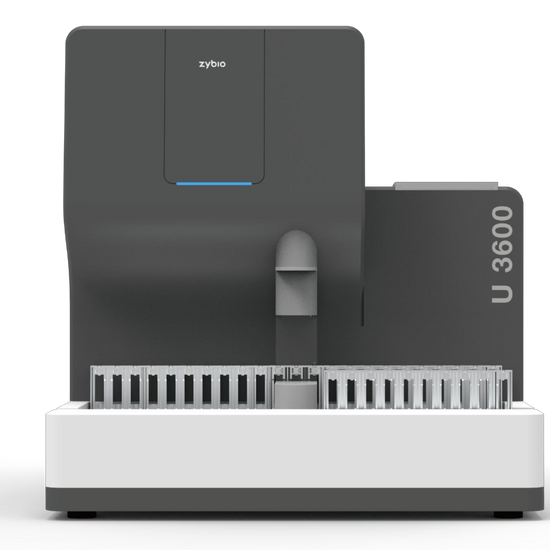The automatic multi-function urine analyzer is a device that has the function of analyzing many indicators combined on the same device: chemical analysis, physical analysis, urine sediment analysis.

- Sediment indices: Red blood cells (RBC), white blood cells (WBC), white blood cells (WBCC), phagocytosis (PHCY), squamous epithelial cells (SQEP), non-squamous epithelial cells (NSE), budding yeast (BYST), yeast with pseudohyphae (HYST), bacilli (BACI), suspected cocci (SUCO), spermatozoa (SPRM), mucus (MUCS), hyaline casts (HYAL ), Unclassified cast (UNCC), fatty, amorphous (AMOR), magnesium ammonium phosphate crystals (MAPH), calcium oxalate monohydrate (COM), calcium oxalate dihydrate crystals (COD), uric acid crystals (URIC ), ammonium urate crystals (AUCR), tyrosine crystals (TYRO), calcium phosphate crystals (CAPH), unclassified (UNCX) and unclassified (UNCL) crystals
- Chemical indicators: Urobilinogen (URO), bilirubin (BIL), ketone body (KET), occult blood (BLD), protein (PRO), nitrite (NIT), white blood cell (WBC), glucose (GLU), specific gravity (SG), pH, Vitamin C (VC), microalbumin (MALB), creatinine (CRE) and calcium (Ca), urine protein/creatinine ratio (P:C), urine microalbumin and creatinine ratio (A:C)
- Physical index: Specific gravity (SG) (optional), turbidity (optional), color (optional), conductivity (optional) and osmotic pressure.
- Provides a comprehensive range of urine analysis methods.
Operating principle:
Principle of sediment analysis: applying the principle of flow microscopic imaging. The device’s hydrodynamic system consists of a specially designed flow cell with a shell structure. After aspirating the sample, the sample enters the flow cell and injects the outer liquid solution (sheath fluid) into the flow cell, surrounded by the outer liquid solution (sheath fluid), the sample enters the thin layer structure . The cells in the sample flow sequentially through the thin layer structure. The deposit area is exposed to a high-frequency light source shaped by the illumination component, while the camera captures images of the deposit at the same frequency and transmits the deposit image to computer software. The computer software analyzes the target sediment images, analyzing the morphology, statistics, frequency domain, and texture of the target image, normalizing these features as input to the classifier. After classifying and calculating using the computer software’s identification algorithm, the urine sample will be discharged into the liquid waste container.
Principle of testing:
Multi-function urine analysis system analyzes the content of biochemical components in urine through color changes due to the reaction of reagents on the strip/test strip with biochemical components in urine according to the principle photoelectric colorimeter.
Turbidity measurement principle: Light from the luminescent tube on the turbidity meter passes through the sample and detects the amount of light scattered by particles in the sample in a direction 90° compared to the incident light. This method of measuring scattered light is called the scattering method.
Color measurement principle: Sample color is checked using an RGB color sensor. Specifically, the sample is irradiated with a white light-emitting diode, where the R, G, and B values are detected by a color sensor after transmission. Then, the sample color is obtained according to the R, G and B values.
Gravimetric measuring principle: The light of the light-emitting diode becomes a beam through the gap and lens device. In addition, light passes through the prism tank containing urine and then radiates out to the reader. The refractive index varies according to the specific gravity of the urine in the prism tank and thus the angle of light relative to the reader.
Specifications:
| Principles | Stratified flow technology |
| High-speed photography technology | |
| Wattage | 240 tests/hour for chemical analysis mode
120 tests/hour for sediment particle analysis mode/combined mode |
| Parameter | Chemical analysis: URO, BIL, KET, LEU, NIT, PRO, BLD, MALB, CRE, GLU, SG, pH, VC, Ca, ACR, PCR |
| Sediment particle analysis: RBC, WBC, WBCC, PHCY, SQEP, NSE, BYST, HYST, BACI, SUCO, SPERM, MUCS, HYAL, UNCC, FAT, AMOR, COM, COD, URIC, AUCR, TYRO, CAPH, MAPH, UNCX, UNCL | |
| Physical analysis: Color, Specific Gravity, Turbidity, Conductivity, Permeability | |
| Sample size | 10 models x 6 stands |
| Testing mode | Automatic loading mode, STAT mode |
| Operating environment | Temperature: 10-30
Humidity: < 80% Pressure 70-106 Hz |
| Power supply | 90-264 V, 47-64 Hz |
| Size | 687 (W) x 512 (D)x 530 (H) |
| Weight (Kg) | 55 |
Product features
Slim design: easy-to-use touch screen, intuitive navigation, integrated physical, chemical and morphological analysis
- Convenient operation: Samples are mixed automatically, no need for centrifugation, emergency samples are prioritized
- Accurate results: High definition images increase detection rate, no overlap, no agglomeration, no change in deposit shape, large, reliable database
Improved productivity: 240 samples/hour for chemical mode





